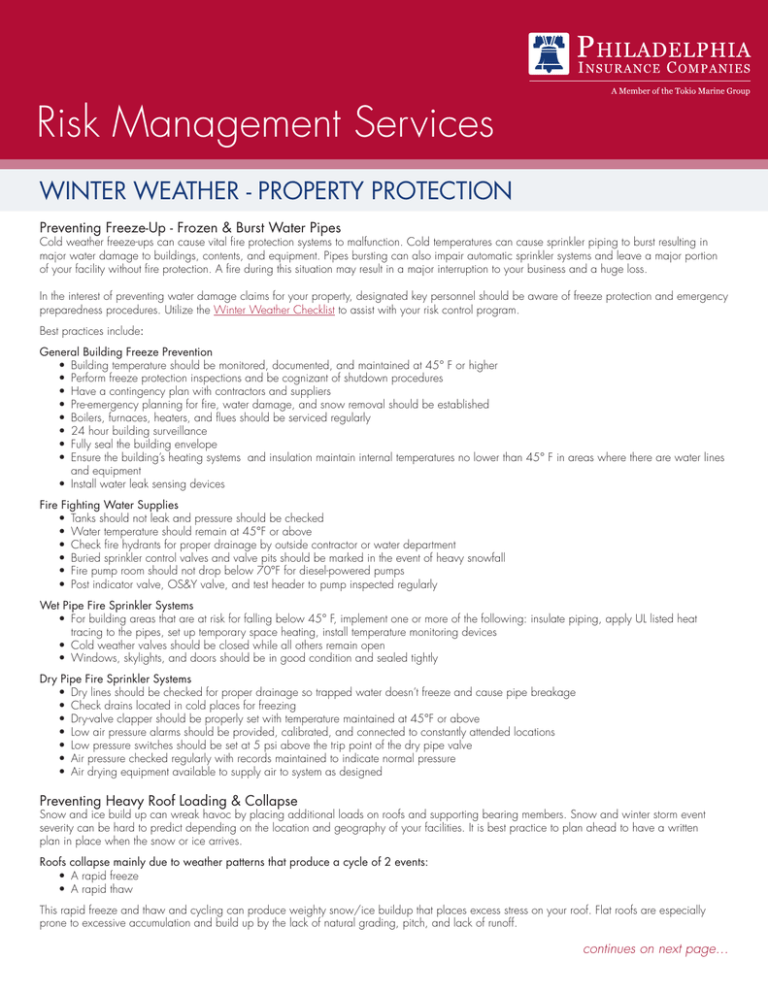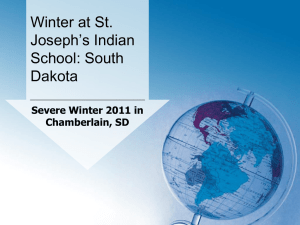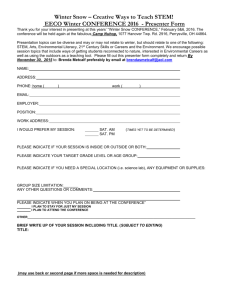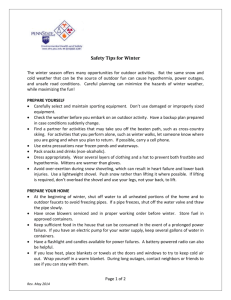
Risk Management Services
WINTER WEATHER - PROPERTY PROTECTION
Preventing Freeze-Up - Frozen & Burst Water Pipes
Cold weather freeze-ups can cause vital fire protection systems to malfunction. Cold temperatures can cause sprinkler piping to burst resulting in
major water damage to buildings, contents, and equipment. Pipes bursting can also impair automatic sprinkler systems and leave a major portion
of your facility without fire protection. A fire during this situation may result in a major interruption to your business and a huge loss.
In the interest of preventing water damage claims for your property, designated key personnel should be aware of freeze protection and emergency
preparedness procedures. Utilize the Winter Weather Checklist to assist with your risk control program.
Best practices include:
General Building Freeze Prevention
• Building temperature should be monitored, documented, and maintained at 45° F or higher
• Perform freeze protection inspections and be cognizant of shutdown procedures
• Have a contingency plan with contractors and suppliers
• Pre-emergency planning for fire, water damage, and snow removal should be established
• Boilers, furnaces, heaters, and flues should be serviced regularly
• 24 hour building surveillance
• Fully seal the building envelope
• Ensure the building’s heating systems and insulation maintain internal temperatures no lower than 45° F in areas where there are water lines
and equipment
• Install water leak sensing devices
Fire Fighting Water Supplies
• Tanks should not leak and pressure should be checked
• Water temperature should remain at 45°F or above
• Check fire hydrants for proper drainage by outside contractor or water department
• Buried sprinkler control valves and valve pits should be marked in the event of heavy snowfall
• Fire pump room should not drop below 70°F for diesel-powered pumps
• Post indicator valve, OS&Y valve, and test header to pump inspected regularly
Wet Pipe Fire Sprinkler Systems
• For building areas that are at risk for falling below 45° F, implement one or more of the following: insulate piping, apply UL listed heat
tracing to the pipes, set up temporary space heating, install temperature monitoring devices
• Cold weather valves should be closed while all others remain open
• Windows, skylights, and doors should be in good condition and sealed tightly
Dry Pipe Fire Sprinkler Systems
• Dry lines should be checked for proper drainage so trapped water doesn’t freeze and cause pipe breakage
• Check drains located in cold places for freezing
• Dry-valve clapper should be properly set with temperature maintained at 45°F or above
• Low air pressure alarms should be provided, calibrated, and connected to constantly attended locations
• Low pressure switches should be set at 5 psi above the trip point of the dry pipe valve
• Air pressure checked regularly with records maintained to indicate normal pressure
• Air drying equipment available to supply air to system as designed
Preventing Heavy Roof Loading & Collapse
Snow and ice build up can wreak havoc by placing additional loads on roofs and supporting bearing members. Snow and winter storm event
severity can be hard to predict depending on the location and geography of your facilities. It is best practice to plan ahead to have a written
plan in place when the snow or ice arrives.
Roofs collapse mainly due to weather patterns that produce a cycle of 2 events:
• A rapid freeze
• A rapid thaw
This rapid freeze and thaw and cycling can produce weighty snow/ice buildup that places excess stress on your roof. Flat roofs are especially
prone to excessive accumulation and build up by the lack of natural grading, pitch, and lack of runoff.
continues on next page...
WINTER WEATHER - PROPERTY PROTECTION - continued
Best practices include:
Ensure that your roofs are in good condition before winter weather hits. Clear all drains of debris. Inspect your roofs, especially the fascia and
drains, making necessary repairs.
Maintain all roofs and keep current with repairs. Winter weather will only further damage any underlayment and the damaging effects of water
infiltration will be costly and may cause business interruptions.
Arrange to have all roofs cleared of snow especially where snow drifts are visible. Hire a competent contractor for this potentially dangerous task.
Request contractor to clear any and all roof drains to allow for runoff and limit ponding especially on flat or relatively shallow pitched roofs. Clear
pathways to the eaves in situations where there is a pitched roof without drainage pipes.
Premises Fire Fighting Efforts
Fire fighting efforts may be hampered due to freezing weather conditions. Therefore, it’s especially important to be vigilant of fire safety during the winter.
Best practices include:
• Remove accumulation of snowfall from your driveways, sidewalks, parking areas, and points of entry to allow for full access by fire fighters
and other first responders
• Clearly mark fire hydrants with colored flags for quick identification and access in the event of high snow drifts
• Strictly enforce no smoking policies
• Ensure fire hazards are well controlled, including cooking areas, combustible and flammable liquids and gases, welding and other hot
work, and building heating equipment
Unoccupied buildings
Vacant, idle, or otherwise “unoccupied” buildings or large buildings with unused space (compartments, floors, rooms, or basements, etc.) present
another set of hazards that an organization must consider for best practice winter weather controls.
Inadvertent releases of water, left unchecked or allowed to flow unnoticed, usually results in extensive interior damage.
Best practices for these situations:
• Maintain fire protection services including water-based fire protection services (sprinklers) - consult your contractor to maintain these
systems in service
• Maintain interior heat at 45°F or greater
• Maintain remote (electronic) monitoring of indoor temperatures
• Visit and survey daily to verify conditions of building or space
• Install water alarms to detect release of water, burst pipe, etc.
Unheated Space
• Close main water valves with potable/domestic water
• Contract a plumbing professional to drain all piping from water heaters, faucets, and supply piping
• Notify proper authorities when plans call for fire protection system (sprinkler) impairment
800.873.4552
IMPORTANT NOTICE - The information and suggestions presented by Philadelphia Indemnity Insurance Company in this e-brochure is for your consideration in your loss prevention efforts.
They are not intended to be complete or definitive in identifying all hazards associated with your business, preventing workplace accidents, or complying with any safety related, or other, laws
or regulations. You are encouraged to alter them to fit the specific hazards of your business and to have your legal counsel review all of your plans and company policies.
Philadelphia Insurance Companies is the marketing name for the insurance company subsidiaries of the Philadelphia Consolidated Holding Corp., a Member of the Tokio Marine Group. Your insurance
policy, and not the information contained in this document, forms the contract between you and your insurance company. If there is a discrepancy or conflict between the information contained herein
and your policy, your policy takes precedence. All coverages are not available in all states due to state insurance regulations. Certain coverage(s) may be provided by a surplus lines insurer. Surplus
lines insurers do not generally participate in state guaranty funds and insureds are therefore not protected by such funds. | © 2013 Philadelphia Consolidated Holding Corp., All Rights Reserved.
Ed. 121114
PHLY.com






